Reduction in Operating Costs and Environmental Impact Consisting in the Modernization of the Low-Power Cylindrical Wood Chipper Power Unit by Using Alternative Fuel
Abstract
1. Introduction
- material
- machine
- wood chips
- method and frequency of feeding of chipped material
- space and terrain topology during the works on chipping processes [75].
2. Materials and Methods
- idling at low speed;
- idling with maximum torque;
- operation through a continuous chipping process.
3. Results
3.1. Fuel Consumption
3.2. Average Productivity of the Chipping Process
4. Discussion
5. Conclusions
Author Contributions
Funding
Conflicts of Interest
References
- EU. Regulation (EU) No 2016/1628 of the European Parliament and of the Council of 14 September 2016. On Requirements for Emission Limit Values of Gaseous and Particulate Pollutants and Type-Approval with Respect to Internal Combustion Engines for Mobile Machines Non-Road, Amending Regulations (EU) No 1024/2012 and (EU) No 167/2013 and Amending and Repealing Directive 97/68/WE; EU: Brussels, Belgium, 2016. [Google Scholar]
- Waluś, K.J.; Warguła, Ł.; Krawiec, P.; Adamiec, J.M. Legal regulations of restrictions of air pollution made by non-road mobile machinery—The case study for Europe: A review. Environ. Sci. Pollut. Res. 2018, 25, 3243–3259. [Google Scholar] [CrossRef] [PubMed]
- Mei, D.; Wang, H.; Dai, P.; Li, X. A statistical analysis of emission features in non-road small SI engines with the same displacement. Proc. Inst. Mech. Eng. Part D J. Automob. Eng. 2018, 232, 1431–1437. [Google Scholar] [CrossRef]
- Warguła, Ł.; Waluś, K.J.; Krawiec, P.; Polasik, J. Electronic control injection-ignition systems in propulsion of non-road mobile machinery. J. Mech. Trans. Eng. 2018, 70, 61–78. [Google Scholar] [CrossRef]
- Lavender, S. Small engine innovations–Current and future. In 17. Internationales Stuttgarter Symposium. Proceedings; Bargende, M., Reuss, H.C., Wiedemann, J., Eds.; Springer Vieweg: Wiesbaden, Germany, 2017; pp. 1567–1574. [Google Scholar]
- Warguła, Ł.; Waluś, K.J.; Krawiec, P. Small engines spark ignited (SI) for non-road mobile machinery—Review. Transport means 2018. In Proceedings of the 22nd International Scientific Conference, Trakai, Lithuania, 3–5 October 2018; pp. 585–591. [Google Scholar]
- Warguła, Ł. Innovative injection-ignition system in a non-road small engine—Construction system. In Proceedings of the 23rd International Scientific Conference, Palanga, Lithuania, 2–4 October 2019; pp. 931–935. [Google Scholar]
- Warguła, Ł.; Krawiec, P.; Waluś, K.J.; Kukla, M. Conceptual design of adaptation of the mechanical fuel injection unit assembly for electronic control. Autobusy Technol. Eksploat. Syst. Transp. 2017, 12, 1381–1386. [Google Scholar]
- Mahmoudzadeh Andwari, A.; Said, M.F.M.; Aziz, A.A.; Esfahanian, V.; Salavati-Zadeh, A.; Idris, M.A.; Perang, M.R.M.; Jamil, H.M. Design, modeling and simulation of a high-pressure gasoline direct injection (GDI) pump for small engine applications. J. Mech. Eng. 2018, 6, 107–120. [Google Scholar]
- Niinikoski, J.; Ewalds, J.; Heikkinen, E.; Kotilainen, J.; Kääriäinen, M.; Tammi, K.; Kiviluoma, P.; Korhonen, A.; Kuosmanen, P. Methods for reducing emissions of small internal combustion engines. In Proceedings of the 11th International DAAAM Baltic Conference, Industrial Engineering, Tallinn, Estonia, 20–22 April 2016. [Google Scholar]
- Warguła, Ł.; Waluś, J.K.; Krawiec, P. Determination of working conditions of mobile chipping wood machines in the aspect of innovative drive control systems. Sylwan 2019, 163, 765–772. [Google Scholar] [CrossRef]
- Warguła, Ł.; Wojtkowiak, D.; Waluś, K.J.; Krawiec, P.; Wieczorek, B. The analysis of the efficiency of the control system of wood chipper’s driver with spark-ignition engine based on Skoda combustion engine 1.459kW. In Proceedings of the 21st International Scientific Conference, Juodkrante, Lithuania, 20–22 September 2017; pp. 452–458. [Google Scholar]
- Kim, H.C.; Park, K.; Nam, M.H.; Park, W.S. Analysis of component damage probability of a small engine based on penetration experiments and M & S. J. Mech. Sci. Technol. 2020, 34, 765–775. [Google Scholar]
- Li, L.; Wang, Z.; Deng, B.; Han, Y.; Wang, H. Combustion and emissions characteristics of a small spark-ignited LPG engine. SAE Technol. Pap. 2002. [Google Scholar] [CrossRef]
- Li, L.; Liu, Z.; Wang, H.; Deng, B.; Wang, Z.; Xiao, Z.; Su, Y.; Jiang, B. Development of a gas-phase LPG injection system for a small SI engine. SAE Technol. Pap. 2003. [Google Scholar] [CrossRef]
- Sulaiman, M.Y.; Ayob, M.R.; Meran, I. Performance of single cylinder spark ignition engine fueled by LPG. Procedia Eng. 2013, 53, 579–585. [Google Scholar] [CrossRef]
- bin Mohd Zain, M.S.; bin Mohamed Soid, S.N.; bin Mior Abd Majid, M.F.; bin Zahelem, M.N. Performance characteristics of a small engine fueled by liquefied petroleum gas. In Advanced Engineering for Processes and Technologies. Advanced Structured Materials; Ismail, A., Abu Bakar, M., Öchsner, A., Eds.; Springer: Berlin/Cham, Germany, 2019; Volume 102, pp. 207–214. [Google Scholar]
- Sabariah, M.S.; Nabilah, A.S.; Rosli, A.B.; Junaidi, Z.Z.; Mustafar, M.T. Analysis and simulation of combustion and emission on small engine. In IOP Conference Series: Materials Science and Engineering; UMP Pekan: Pahang, Malaysia, 2019; Volume 469. [Google Scholar]
- Schirmer, W.N.; Olanyk, L.Z.; Guedes, C.L.B.; Quessada, T.P.; Ribeiro, C.B.; Capanema, M.A. Effects of air/fuel ratio on gas emissions in a small spark-ignited non-road engine operating with different gasoline/ethanol blends. Environ. Sci. Pollut. Res. 2017, 24, 20354–20359. [Google Scholar] [CrossRef] [PubMed]
- Ribeiro, C.B.; Martins, K.G.; Gueri, M.V.D.; Pavanello, G.P.; Schirmer, W.N. Effect of anhydrous ethanol/gasoline blends on performance and exhaust emissions of spark-ignited non-road engines. Environ. Sci. Pollut. Res. 2018, 25, 24192–24200. [Google Scholar] [CrossRef] [PubMed]
- Gong, C.; Li, Z.; Huang, K.; Liu, F. Research on the performance of a hydrogen/methanol dual-injection assisted spark-ignition engine using late-injection strategy for methanol. Fuel 2020, 260, 116403. [Google Scholar] [CrossRef]
- EU. Directive 2014/94/EU of the European Parliament and of the Council of 22 October 2014 on the Deploy-Ment of Alternative Fuels Infrastructure Text with EEA Relevance; EU: Strasbourg, France, 2014. [Google Scholar]
- Szpica, D.; Czaban, J. Operational assessment of selected gasoline and LPG vapour injector dosage regularity. Mechanika 2014, 20, 480–489. [Google Scholar] [CrossRef]
- Saraf, R.R.; Thipse, S.S.; Saxena, P.K. Comparative emission analysis of gasoline/LPG automotive bifuel engine. Int. J. Civ. Environ. Eng. 2009, 1, 199–202. [Google Scholar]
- Tasic, T.; Pogorevc, P.; Brajlih, T. Gasoline and LPG exhaust emissions comparison. Adv. Prod. Eng. Manag. 2011, 6, 87–94. [Google Scholar]
- Zeng, X.-W.; Vivian, E.; Mohammed, K.A.; Jakhar, S.; Vaughn, M.; Huang, J.; Zelicoff, A.; Xaverius, P.; Bai, Z.; Lin, S.; et al. Long-term ambient air pollution and lung function impairment in Chinese children from a high air pollution range area: The seven Northeastern cities (SNEC) study. Atmos. Environ. 2016, 138, 144–151. [Google Scholar] [CrossRef]
- Tang, G.; Zhao, P.; Wang, Y.; Gao, W.; Chang, M.; Xin, J.; Li, X.; Wang, Y. Mortality and air pollution in Beijing: The long-term relationship. Atmos. Environ. 2017, 150, 238–243. [Google Scholar] [CrossRef]
- Czerwiński, J.; Kurzwart, M.; Mayer, A.; Comte, P. Particle emissions of modern handheld machines. SAE Technol. Pap. 2014. [Google Scholar] [CrossRef]
- Merkisz, J.; Lijewski, P.; Pielecha, J. PEMS-based investigations into exhaust emissions from non-road and rail vehicles. Combust. Engines 2016, 166, 46–53. [Google Scholar] [CrossRef]
- Liu, S.; Han, W.; Zeng, J.; Wang, J. Analysis of combustion and emission characteristics of electronic controlled low pressure injected small gasoline engine. Trans. Chin. Soc. Agric. Eng. 2016, 32, 92–97. [Google Scholar] [CrossRef]
- Dimou, V.; Anezakis, V.; Demertzis, K.; Iliadis, L.S. Comparative analysis of exhaust emissions caused by chainsaws with soft computing and statistical approaches. Int. J. Environ. Sci. Technol. 2017, 3–14. [Google Scholar] [CrossRef]
- Lijewski, P.; Fuć, P.; Dobrzyński, M.; Markiewicz, F. Exhaust emissions from small engines in handheld devices. In MATEC Web of Conferences, VII International Congress on Combustion Engines, Poznań, Poland, 27–29 June 2017; EDP Sciences: Lez Ili, France, 2017; Volume 118. [Google Scholar]
- Hooper, B.; Parker, R.; Todoroki, C. Exploring chainsaw operator occupational exposure to carbon monoxide in forestry. J. Occup. Environ. Hyg. 2017, 14, D1–D12. [Google Scholar] [CrossRef] [PubMed]
- Magagnotti, N.; Picchi, G.; Sciarra, G.; Spinelli, R. Exposure of mobile chipper operators to diesel exhaust. Ann. Occup. Hyg. 2014, 58, 217–226. [Google Scholar] [PubMed]
- Wang, F.; Li, Z.; Zhang, K.; Di, B.; Hu, B. An overview of non-road equipment emissions in China. Atmos. Environ. 2016, 132, 283–289. [Google Scholar] [CrossRef]
- Guo, X.; Wu, H.; Chen, D.; Ye, Z.; Shen, Y.; Liu, J.; Cheng, S. Estimation and prediction of pollutant emissions from agricultural and construction diesel machinery in the Beijing-Tianjin-Hebei (BTH) region, China. Environ. Pollut. 2020, 113973. [Google Scholar] [CrossRef] [PubMed]
- Baldauf, R.; Fortune, C.; Weinstein, J.; Wheeler, M.; Blanchard, F. Air contaminant exposures during the operation of lawn and garden equipment. J. Expo. Sci Environ. Epidemiol 2006, 16, 362–370. [Google Scholar] [CrossRef] [PubMed]
- Paton-Walsh, C.; Rayner, P.; Simmons, J.; Fiddes, S.L.; Schofield, R.; Bridgman, H.; Beaupark, S.; Broome, R.; Chambers, S.D.; Chang, L.T.-C.; et al. A clean air plan for Sydney: An overview of the special issue on air quality in New South Wales. Atmosphere 2019, 10, 774. [Google Scholar] [CrossRef]
- Marchant-Fuentes, C.; Leiva, V.; Christakos, G.; Cavieres, M.F. Monitoring urban environmental pollution by bivariate control charts: New methodology and case study in Santiago, Chile. Environmetrics 2019, 30, e2551. [Google Scholar] [CrossRef]
- Jury, M.R. Meteorology of air pollution in Los Angeles. Atmos. Pollut. Res. 2020, in press. [Google Scholar] [CrossRef]
- Yu, S.; Li, P.; Wang, L.; Wu, Y.; Wang, S.; Liu, K.; Zhu, T.; Zhang, Y.; Hu, M.; Zeng, L.; et al. Mitigation of severe urban haze pollution by a precision air pollution control approach. Sci. Rep. 2018, 8, 1–11. [Google Scholar] [CrossRef] [PubMed]
- Hassan, S.K.; Khoder, M.I. Chemical characteristics of atmospheric PM2.5 loads during air pollution episodes in Giza, Egypt. Atmos. Environ. 2017, 150, 346–355. [Google Scholar] [CrossRef]
- Smurzyńska, A.; Czekała, W.; Hektus, P.; Marks, S.; Mazurkiewicz, J.; Brzoski, M.; Chełkowski, D.; Kozłowski, K. Poznań air pollution analysis for 2015–2017. J. Ecol. Eng. 2018, 19. [Google Scholar] [CrossRef]
- Zijlema, W.L.; Wolf, K.; Emeny, R.; Ladwig, K.H.; Peters, A.; Kongsgård, H.; Hveem, K.; Kvaløy, K.; Yli-Tuomi, T.; Partonen, T.; et al. The association of air pollution and depressed mood in 70,928 individuals from four European cohorts. Int. J. Hyg. Environ. Health 2016, 219, 212–219. [Google Scholar] [CrossRef] [PubMed]
- Le Boennec, R.; Salladarré, F. The impact of air pollution and noise on the real estate market. The case of the 2013 European green capital: Nantes, France. Ecol. Econ. 2017, 138, 82–89. [Google Scholar] [CrossRef]
- Lichter, A.; Pestel, N.; Sommer, E. Productivity effects of air pollution: Evidence from professional soccer. Labour Econ. 2017, 48, 54–66. [Google Scholar] [CrossRef]
- Sack, C.S.; Kaufman, J.D. Air pollution levels and children’s lung health. How low do we need to go? Am. J. Respir. Crit. Care Med. 2016, 193, 819–820. [Google Scholar] [CrossRef] [PubMed]
- Sanidas, E.; Papadopoulos, G.H.; Velliou, M.; Tsioufis, K.; Barbetseas, J.; Papademetriou, V. Air pollution and arterial hypertension. A new risk factor is in the air. J. Am. Soc. Hyperten 2017, 11, 709–715. [Google Scholar] [CrossRef] [PubMed]
- Cheng, I.; Tseng, C.; Wu, J.; Yang, J.; Conroy, S.M.; Shariff-Marco, S.; Li, L.; Hertz, A.; Gomez, S.L.; Marchand, L.L.; et al. Association between ambient air pollution and breast cancer risk: The multiethnic cohort study. Int. J. Cancer 2020, 146, 699–711. [Google Scholar] [CrossRef] [PubMed]
- WHO Regional Office for Europe; OECD. Eco-Nomic Cost of the Health Impact of Air Pollution in Europe: Clean Air, Health and Wealth; WHO Regional Office for Europe: Copenhagen, Denmark, 2015. [Google Scholar]
- Badyd, A.J.; Grellier, J.; Dąbrowiecki, P. Ambient PM2.5 exposure and mortality due to lung cancer and cardiopulmonary diseases in Polish cities. Adv. Exp. Med. Biol. 2017, 944, 9–17. [Google Scholar] [CrossRef]
- Lovarelli, D.; Bacenetti, J. Exhaust gases emissions from agricultural tractors: State of the art and future perspectives for machinery operators. Biosyst. Eng. 2019, 186, 204–213. [Google Scholar] [CrossRef]
- Peters, S.; de Klerk, N.; Reid, A.; Fritschi, L.; Musk, A.B.; Vermeulen, R. Estimation of quantitative levels of diesel exhaust exposure and the health impact in the contemporary Australian mining industry. Occup. Environ. Med. 2017, 74, 282–289. [Google Scholar] [CrossRef] [PubMed]
- Oguntoke, O.; Adeyemi, A. Degradation of urban environment and human health by emissions from fossil-fuel combusting electricity generators in Abeokuta metropolis, Nigeria. Indoor Built Environ. 2017, 26, 538–550. [Google Scholar] [CrossRef]
- Brüske-Hohlfeld, I.; Möhner, M.; Ahrens, W.; Pohlabeln, H.; Heinrich, J.; Kreuzer, M.; Jöckel, K.H.; Wichmann, H.E. Lung cancer risk in male workers occupationally exposed to diesel motor emissions in Germany. Am. J. Ind. Med. 1999, 36, 405–414. [Google Scholar] [CrossRef]
- McEwan, A.; Brink, M.; Spinelli, R. Efficiency of different machine layouts for chain flail delimbing, debarking and chipping. Forests 2019, 10, 126. [Google Scholar] [CrossRef]
- Spinelli, R.; Eliasson, L.; Magagnotti, N. Value retention, service life, use intensity and long-term productivity of wood chippers as obtained from contractor records. Forests 2017, 8, 503. [Google Scholar] [CrossRef]
- Spinelli, R.; Cavallo, E.; Eliasson, L.; Facello, A.; Magagnotti, N. The effect of drum design on chipper performance. Renew. Energy 2015, 81, 57–61. [Google Scholar] [CrossRef]
- Spinelli, R.; Magagnotti, N. Determining long-term chipper usage, productivity and fuel consumption. Biomass Bioenerg. 2014, 66, 442–449. [Google Scholar] [CrossRef]
- Spinelli, R.; Magagnotti, N. Performance of a small-scale chipper for professional rural contractors. Sci. Pract. 2013, 15, 206–213. [Google Scholar] [CrossRef]
- Spinelli, R.; Glushkov, S.; Markov, I. Managing chipper knife wear to increase chip quality and reduce chipping cost. Biomass Bioenerg. 2014, 62, 117–122. [Google Scholar] [CrossRef]
- Spinelli, R.; Eliasson, L.; Magagnotti, N. Increasing wood fuel processing efficiency by fine-tuning chipper settings. Fuel Process. Technol. 2016, 151, 126–130. [Google Scholar] [CrossRef]
- Choi, Y.S.; Cho, M.J.; Paik, S.H.; Mun, H.S.; Kim, D.H.; Han, S.K.; Oh, J.H. Factors affecting the chipping operation based on the screen size of the drum chipper. Forests 2019, 10, 1029. [Google Scholar] [CrossRef]
- Spinelli, R.; Magagnotti, N.; Paletto, G.; Preti, C. Determining the impact of some wood characteristics on the performance of a mobile chipper. Silva Fenn. 2011, 45, 85–95. [Google Scholar] [CrossRef]
- Nati, C.; Spinelli, R.; Fabbri, P. Wood chips size distribution in relation to blade wear and screen use. Biomass Bioenerg. 2010, 34, 583–587. [Google Scholar] [CrossRef]
- Nati, C.; Spinelli, R. How blade wear of chippers can affect fuel consumption and wood chip size distribution. In Proceedings of the Forest Engeneering: Meeting the Needs of the Society and the Environment, FORMEC 2010, Padova, Italia, 11–14 July 2010; pp. 1–7. [Google Scholar]
- Nati, C.; Eliasson, L.; Spinelli, R. Effect of chipper type, biomass type and blade wear on productivity, fuel consumption and product quality. Croat. J. Eng. 2014, 35, 1–7. [Google Scholar]
- Nati, C.; Eliasson, L.; Spinelli, R. Fuel consumption and productivity for two tractor-mounted chippers in relation to knife wear and raw material. In Proceedings of the Formec 2011 Conference Pushing the Boundaries with Research and Innovation in Forest Engineering, Graz, Austria, 9–13 October 2011; pp. 1–8. [Google Scholar]
- Eliasson, L.; von Hofsten, H.; Johannesson, T.; Spinelli, R.; Thierfelder, T. Effects of sieve size on chipper productivity, fuel consumption and chip size distribution for open drum chippers. Croat. J. Eng. 2015, 36, 11–17. [Google Scholar]
- Pochi, D.; Civitarese, V.; Fanigliulo, R.; Spinelli, R.; Pari, L. Effect of poplar fuel wood storage on chipping performance. Fuel Process. Technol. 2015, 134, 116–121. [Google Scholar] [CrossRef]
- Ghaffariyan, M.R.; Sessions, J.; Brown, M. Evaluating productivity, cost, chip quality and biomass recovery for a mobile chipper in Australian roadside chipping operations. J. Sci. 2012, 58, 530–535. [Google Scholar] [CrossRef]
- Magagnotti, N.; Spinelli, R. Determining the effect of feedstock type and chipping productivity, fuel consumption and quality output. In Proceedings of the Formec 2011 Conference Pushing the Boundaries with Research and Innovation in Forest Engineering, Graz, Austria, 9–13 October 2011; pp. 1–8. [Google Scholar]
- Irdla, M.; Padari, A.; Kurvits, V.; Muiste, P. The chipping cost of wood raw material for fuel in Estonian conditions. For. Stud. 2017, 66, 65–74. [Google Scholar] [CrossRef]
- Kuptz, D.; Hartmann, H. Throughput rate and energy consumption during wood chip production in relation to raw material, chipper type and machine setting. In Proceedings of the 22nd European Biomass Conference and Exhibition, Hamburg, Germany, 23–26 June 2014. [Google Scholar]
- Mihelič, M.; Spinelli, R.; Poje, A. Production of wood chips from logging residue under space-constrained conditions. Croat. J. Eng. 2018, 39, 223–232. [Google Scholar]
- Facello, A.; Cavallo, E.; Magagnotti, N.; Paletto, G.; Spinelli, R. The effect of chipper cut length on wood fuel processing performance. Fuel Process. Technol. 2013, 116, 228–233. [Google Scholar] [CrossRef]
- Assirelli, A.; Civitarese, V.; Fanigliulo, R.; Pari, L.; Pochi, D.; Santangelo, E.; Spinelli, R. Effect of piece size and tree part on chipper performance. Biomass Bioenerg. 2013, 54, 77–82. [Google Scholar] [CrossRef]
- Poje, A.; Spinelli, R.; Magagnotti, N.; Mihelic, M. Exposure to noise in wood chipping operations under the conditions of agro-forestry. Int. J. Ind. Ergon. 2015, 50, 151–157. [Google Scholar] [CrossRef]
- Manzone, M.; Spinelli, R. Wood chipping performance of a modified forager. Biomass Bioenerg. 2013, 55, 101–106. [Google Scholar] [CrossRef]
- Manzone, M.; Balsari, P. Productivity and woodchip quality of different chippers during poplar plantation harvesting. Biomass Bioenerg. 2015, 83, 278–283. [Google Scholar] [CrossRef]
- Mihelič, M.; Spinelli, R.; Magagnotti, N.; Poje, A. Performance of a new industrial chipper for rural contractors. Biomass Bioenerg. 2015, 83, 152–158. [Google Scholar] [CrossRef]
- Shahid, L.A.; Amjad, N.; Siddhu, M.A.H. Adaptation and performance evaluation of a tractor operated wood chipper shredder. Pak. J. Agric. Res. 2019, 32, 197–204. [Google Scholar] [CrossRef]
- Colantoni, A.; Mazzocchi, F.; Laurendi, V.; Grigolato, S.; Monarca, F.; Monarca, D.; Cecchini, M. Innovative solution for reducing the run-down time of the chipper disc using a brake clamp device. Agriculture 2017, 7, 71. [Google Scholar] [CrossRef]
- Manzone, M. Energy consumption and CO2 analysis of different types of chippers used in wood biomass plantations. Appl. Energy 2015, 156, 686–692. [Google Scholar] [CrossRef]
- Laitila, J.; Routa, J. Performance of a small and medium sized professional chippers and the impact of storage time on Scots pine (Pinus sylvestris) stem wood chips characteristics. Silva Fenn. 2015. [Google Scholar] [CrossRef]
- Han, S.K.; Han, H.S.; Bisson, J.A. Effects of grate size on grinding productivity, fuel consumption, and particle size distribution. Prod. J. 2015, 65, 209–216. [Google Scholar] [CrossRef]
- Jasinskas, A.; Ulozeviciute, I.; Sarauskis, E.; Sakalauskas, A.; Puskunigis, M. Determination of energy plant chopping quality and emissions while burning chaff. Agron. Res. 2011, 9, 49–61. [Google Scholar]
- Spinelli, R.; Nati, C.; Sozzi, L.; Magagnotti, N.; Picchi, G. Physical characterization of commercial woodchips on the Italian energy market. Fuel 2011, 90, 2198–2202. [Google Scholar] [CrossRef]
- Prada, M.; Martínez-Alonso, C.; Sánchez-García, S.; Canga, E. Analysis of three forest chippers: Productivity, costs and GHG emissions in Northern Spain. J. Clean. Prod. 2015, 101, 238–244. [Google Scholar] [CrossRef]
- Pari, L.; Suardi, A.; Del Giudice, A.; Scarfone, A.; Santangelo, E. Influence of chipping system on chipper performance and wood chip particle size obtained from peach prunings. Biomass Bioenerg. 2018, 112, 121–127. [Google Scholar] [CrossRef]
- Spinelli, R.; Magagnotti, N. The effect of raw material, cut length, and chip discharge on the performance of an industrial chipper. Prod. J. 2012, 62, 584–589. [Google Scholar] [CrossRef]
- Bello, S.R.; Onilude, M.A. Force relations and dynamics of cutting knife in a vertical disc mobile wood chipper. Leonardo Electron. J. Pract. Technol. 2011, 18, 17–34. [Google Scholar]
- Rebaki24—Catalog. Available online: https://rebaki24.pl/pl/ (accessed on 6 January 2018).
- German GX 390—Catalog. Available online: http://www.i-ogrod.pl/silnik-spalinowy-german-13km-gx390-zageszczarka-p-1481.html (accessed on 6 January 2018).
- Carburettor LPG. Available online: https://archiwum.allegro.pl/oferta/gaznik-lpg-cng-dwufunkcyjny-168f-agregat-gx160-390-i7476479018.html (accessed on 6 January 2018).
- Merkisz, J.; Dobrzyński, M.; Kozak, M.; Lijewski, P.; Fuć, P. Environmental aspects of the use of cng in public urban transport. Altern. Fuels Technol. Environ. Cond. 2016. [Google Scholar] [CrossRef]
- Warguła, Ł.; Waluś, K.J.; Krawiec, P.; Kukla, M. Research of the ignition advance angle characteristics on the example of a German GX 390 combustion engine. Autobusy Technol. Eksploat. Syst. Transp. 2017, 12, 1387–1391. [Google Scholar]
- Warguła, Ł.; Kaczmarzyk, P.; Dziechciarz, A. The assessment of fire risk of non-road mobile wood chopping machines. J. Res. Appl. Agric. Eng. 2019, 64, 58–64. [Google Scholar]
- Serdecki, W. Testing of Internal Combustion Engines; Poznan University of Technology: Poznań, Poland, 2012; ISBN 978-83-7775-105-3. [Google Scholar]
- Rychlik, A. Commercial vehicles fuel consumption measurement methods. Maint. Reliab. 2006, 4, 37–41. [Google Scholar]
- ISO; IEC; OIML. Guide to the Expression of Uncertainty in Measurement; International Electrotechnical Commission: Geneva, Switzerland, 1995. [Google Scholar]
- ISO. International Vocabulary of Basic and General Terms in Metrology; International Organization for Standardization: Geneva, Switzerland, 1993. [Google Scholar]
- ISO. International Standard ISO 3534-1: (1993) (E/F) Statistics—Vocabulary and Symbols; International Organization for Standardization: Geneva, Switzerland, 1993. [Google Scholar]
- Kendall, M.G.; Stuart, A. The Advanced Theory of Statistics; Charles Griffin & Company Limited: London, UK, 1966. [Google Scholar]
- Kołodziej, S.; Graba, M.; Bieniek, A. Power efficiency of a internal combustion engine powered by liquefied petroleum gas. TTS Technol. Transp. Szyn. 2015, 22, 796–799. [Google Scholar]
- Małek, A. The requirements for emission standards Euro 5 for vehicles fueled by LPG. Autobusy Technol. Eksploat. Syst. Transp. 2011, 12, 289–294. [Google Scholar]
- Abramek, K.F.; Uzdowski, M. Some aspects of exploitation vehicles using gaseous fuels. Autobusy Technol. Eksploat. Syst. Transp. 2012, 13, 39–42. [Google Scholar]
- Rahman, S. Another perspective on gasoline price responses to crude oil price changes. Energy Econ. 2016, 55, 10–18. [Google Scholar] [CrossRef]
- Sjoquist, D.L.; Tang, X. Differential effects of federal and state gasoline taxes on gasoline consumption. Proc. Annu. Conf. Tax. Minutes Annu. Meet. Natl. Tax Assoc. 2017, 110, 1–10. [Google Scholar]
- Noel, M.D. Calendar synchronization of gasoline price increases. J. Econ. Manag. Strategy 2019, 28, 355–370. [Google Scholar] [CrossRef]
- Koay, L.K.; Sah, M.J.M.; Othman, R.B. Comparative study of fuel consumption, acceleration and emission for road vehicle using LPG or gasoline. Adv. Eng. Process. Technol. 2019, 77–87. [Google Scholar] [CrossRef]
- Park, G.; Mun, S.; Hong, H.; Chung, T.; Jung, S.; Kim, S.; Seo, S.; Kim, J.; Lee, J.; Kim, K.; et al. Characterization of emission factors concerning gasoline, LPG, and diesel vehicles via transient chassis-dynamometer tests. Appl. Sci. 2019, 9, 1573. [Google Scholar] [CrossRef]
- Szpica, D. Coefficient of engine flexibility as a basis for the assessment of vehicle tractive performance. Chin. J. Mech. Eng. 2019, 32, 1–12. [Google Scholar] [CrossRef]
- Szpica, D.; Piwnik, J.; Sidorowicz, M. The motion storage characteristics as the indicator of stability of internal combustion engine—Receiver cooperation. Mechanika 2014, 20, 108–112. [Google Scholar] [CrossRef][Green Version]
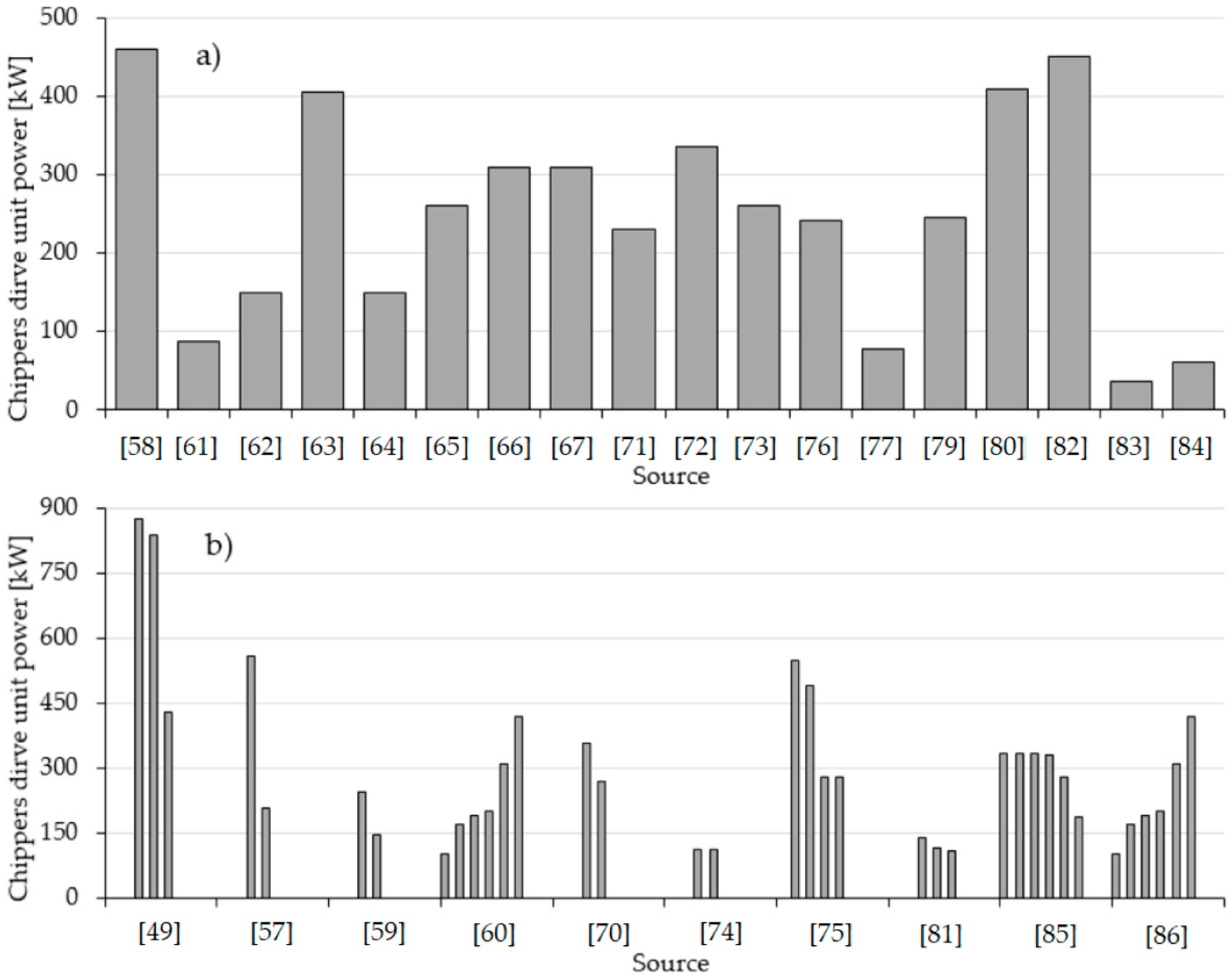
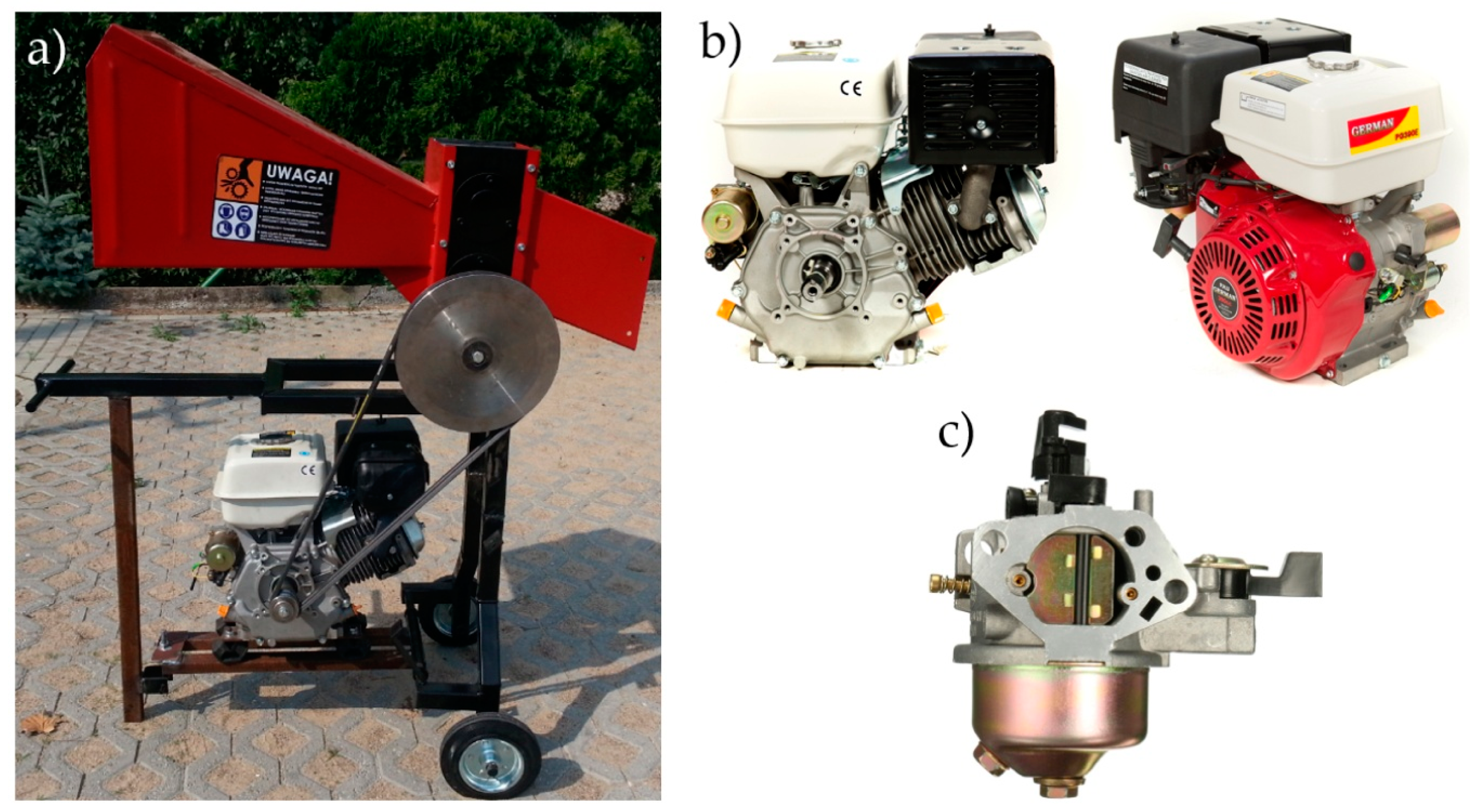
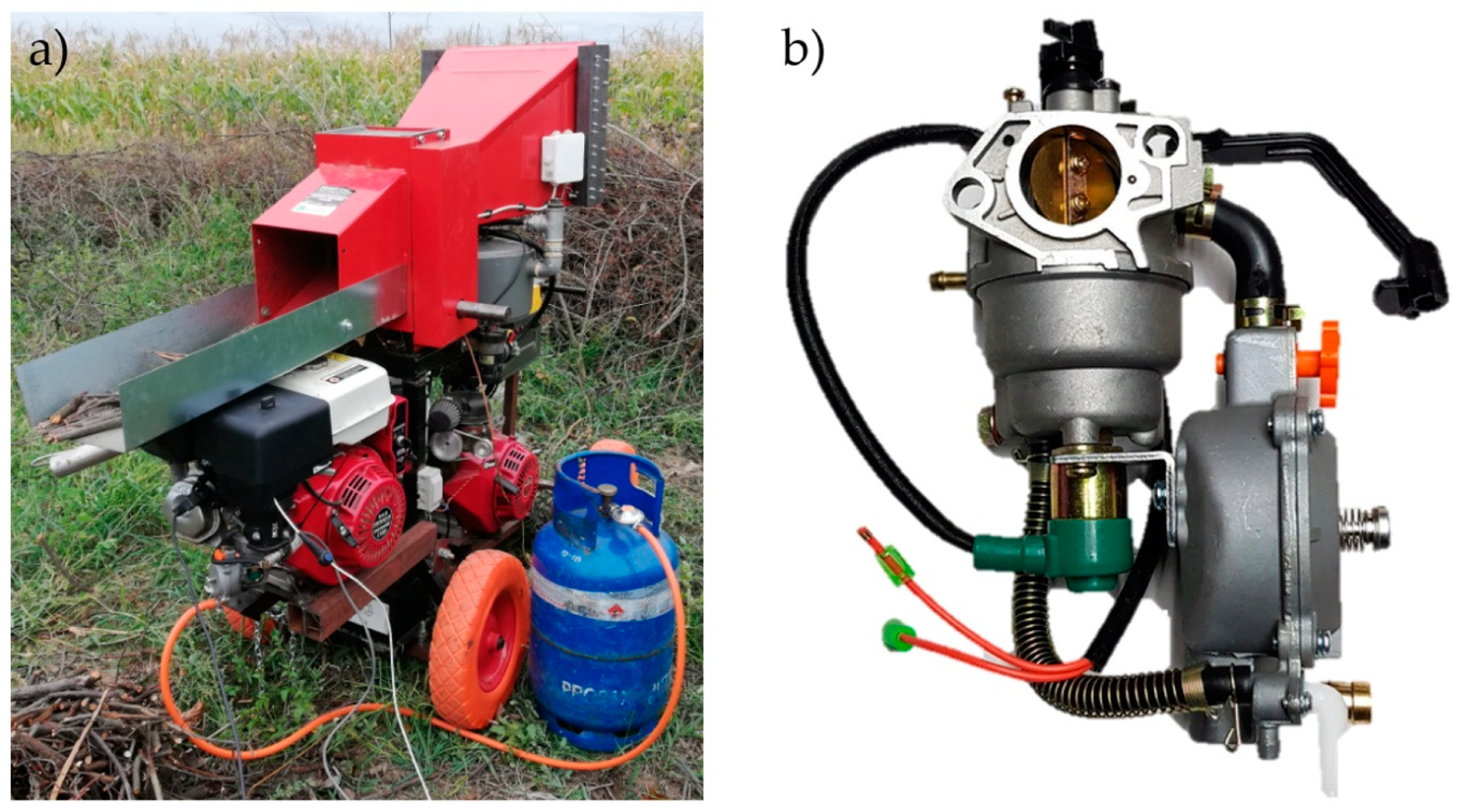
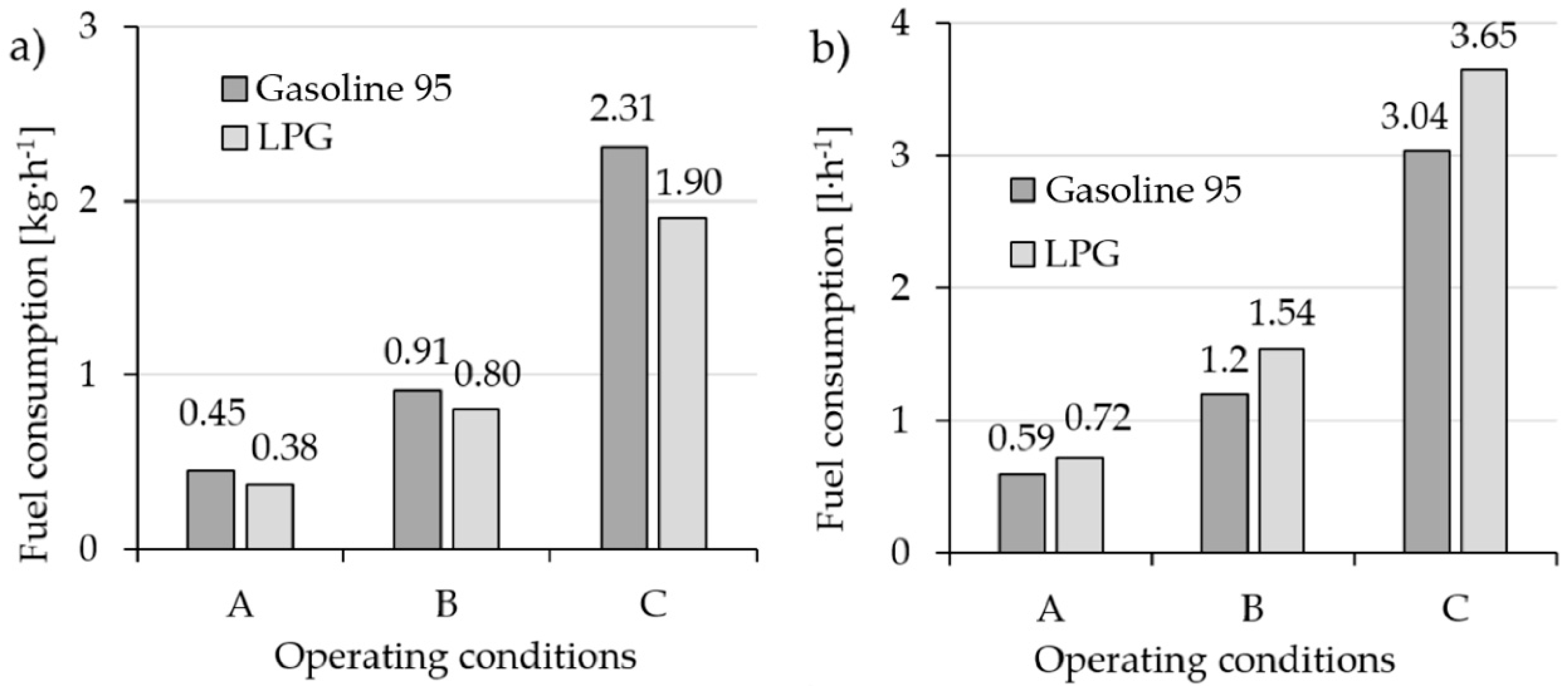
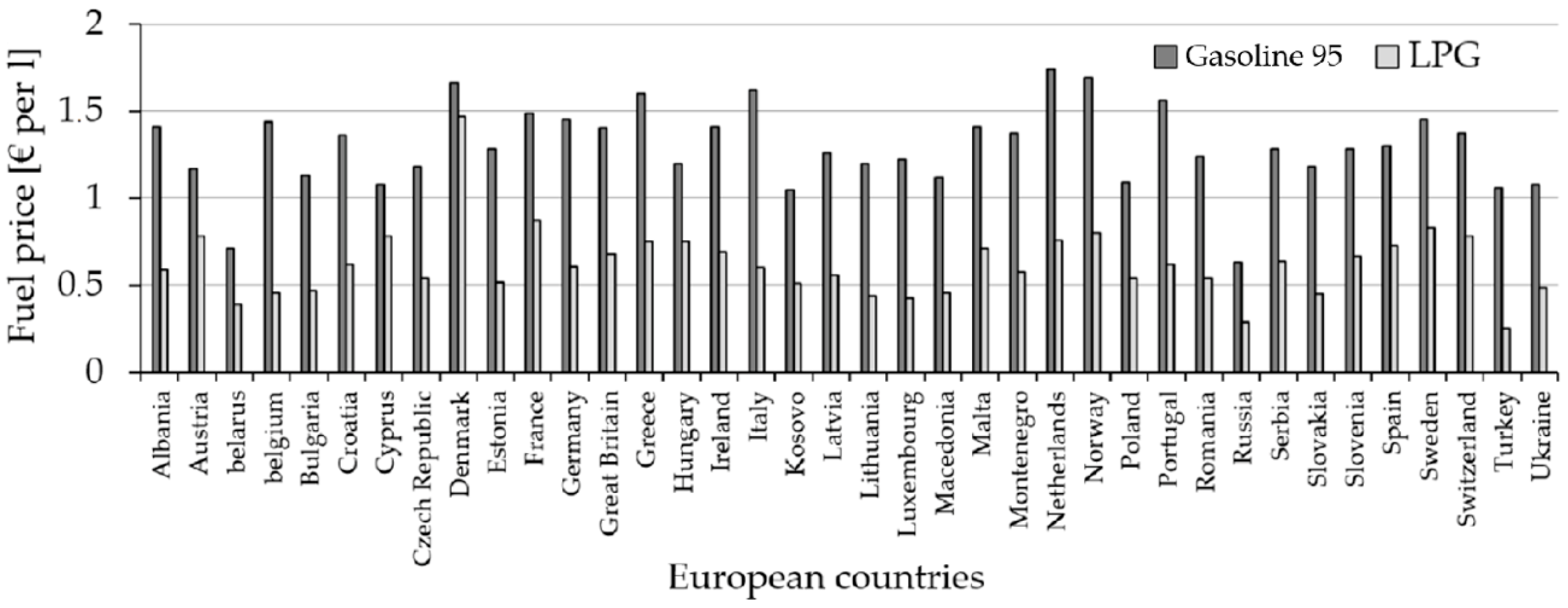
| Parameter | Characteristic |
|---|---|
| Swept volume | 389 cm3 |
| Engine maximal power at 3600 rpm | 9.56 kW/13 HP |
| Engine maximal torque at 2500 rpm | 26.5 Nm |
| Bore/Stroke | 88 mm /64 mm |
| Engine Type | Four-stroke, OHV (Over Head Valve) |
| Number of cylinders | 1 |
| Ignition | Electronic, without ignition timing adjustment [97] |
| Weight | 31 kg |
| Average cost | EUR 270 |
| Fuel | Gasoline 95 | Liquefied Petroleum Gas Propane–Butane 50%/50% |
|---|---|---|
| Density under reference conditions (liquid phase) [kg (m3)−1] | 720–775 | 520 |
| Fuel calorific value [MJ kg−1] | 42.6 | 46 |
| Boiling temperature [°C] | 40–210 | −30 |
| Excess air coefficient λ up to the ignitability boundaries | 0.4–1.4 | 0.4–1.7 |
| Octane number MON (RON) | 85 (95) | 95 (100) |
| Air fuel ratio (AFR) for stoichiometric mix | 14.7:1 | 15.5:1 |
| Test No. | Idle Work with Low Rotational Speed [kg h−1] | Idle Work with High Rotational Speed [kg h−1] | Continuous Chipping [kg h−1] | |||
|---|---|---|---|---|---|---|
| A | B | A | B | A | B | |
| 1 | 0.455 | 0.375 | 0.887 | 0.752 | 2.319 | 1.823 |
| 2 | 0.470 | 0.345 | 0.875 | 0.782 | 2.521 | 1.945 |
| 3 | 0.432 | 0.331 | 0.929 | 0.811 | 2.287 | 2.011 |
| 4 | 0.443 | 0.389 | 0.921 | 0.862 | 2.312 | 1.954 |
| 5 | 0.454 | 0.353 | 0.892 | 0.798 | 2.274 | 1.887 |
| 6 | 0.443 | 0.412 | 0.935 | 0.743 | 2.509 | 1.898 |
| 7 | 0.466 | 0.375 | 0.859 | 0.815 | 2.292 | 1.789 |
| 8 | 0.481 | 0.385 | 0.923 | 0.832 | 2.141 | 1.873 |
| 9 | 0.429 | 0.394 | 0.935 | 0.843 | 2.648 | 1.923 |
| 10 | 0.431 | 0.388 | 0.944 | 0.773 | 2.251 | 1.902 |
| AVG | 0.450 | 0.375 | 0.914 | 0.801 | 2.311 | 1.901 |
| SD | 0.0056 | 0.0078 | 0.0092 | 0.0123 | 0.0485 | 0.0203 |
| I | 0.013 | 0.017 | 0.021 | 0.027 | 0.108 | 0.045 |
| Test No. | [kg] | [h] |
|---|---|---|
| 1 | 24.50 | 0.0220 |
| 2 | 19.50 | 0.0233 |
| 3 | 21.50 | 0.0380 |
| 4 | 27.50 | 0.0405 |
| 5 | 21.00 | 0.0382 |
| 6 | 21.50 | 0.0425 |
| 7 | 20.00 | 0.0428 |
| 8 | 22.50 | 0.0350 |
| 9 | 26.10 | 0.0258 |
| 10 | 22.40 | 0.0350 |
| AVG | 22.65 | 0.0343 |
| SD | 2.61 | 0.0078 |
| 0.32 | 0.1124 |
| System Components and Service | Cost |
|---|---|
| Carburetor | 46 € |
| LPG gas reducer with pressure gauge | 7 € |
| Installation hose | 6 € |
| 11 kg gas tank | 23 € |
| Working time spent on the modernization of the structure and system regulation 1 h | 23 € |
© 2020 by the authors. Licensee MDPI, Basel, Switzerland. This article is an open access article distributed under the terms and conditions of the Creative Commons Attribution (CC BY) license (http://creativecommons.org/licenses/by/4.0/).
Share and Cite
Warguła, Ł.; Kukla, M.; Krawiec, P.; Wieczorek, B. Reduction in Operating Costs and Environmental Impact Consisting in the Modernization of the Low-Power Cylindrical Wood Chipper Power Unit by Using Alternative Fuel. Energies 2020, 13, 2995. https://doi.org/10.3390/en13112995
Warguła Ł, Kukla M, Krawiec P, Wieczorek B. Reduction in Operating Costs and Environmental Impact Consisting in the Modernization of the Low-Power Cylindrical Wood Chipper Power Unit by Using Alternative Fuel. Energies. 2020; 13(11):2995. https://doi.org/10.3390/en13112995
Chicago/Turabian StyleWarguła, Łukasz, Mateusz Kukla, Piotr Krawiec, and Bartosz Wieczorek. 2020. "Reduction in Operating Costs and Environmental Impact Consisting in the Modernization of the Low-Power Cylindrical Wood Chipper Power Unit by Using Alternative Fuel" Energies 13, no. 11: 2995. https://doi.org/10.3390/en13112995
APA StyleWarguła, Ł., Kukla, M., Krawiec, P., & Wieczorek, B. (2020). Reduction in Operating Costs and Environmental Impact Consisting in the Modernization of the Low-Power Cylindrical Wood Chipper Power Unit by Using Alternative Fuel. Energies, 13(11), 2995. https://doi.org/10.3390/en13112995








